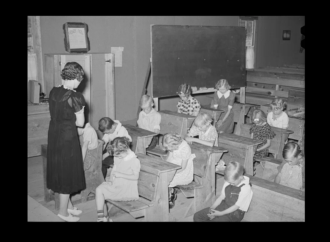In spite of the fact that we are living today in a sex-saturated cultural environment, recent studies surprisingly report that sexual relations between men and women are declining. “In 2018, the share of Americans who said they didn’t have sex for an entire year was the highest on record.” This statistic includes both single individuals and married couples.
Such news has consequences, both positive and negative. From a positive perspective, unmarried teen pregnancy rates are the lowest they have been for decades; nearly 60 percent of high school students have never had sex, up from 46 percent in 1991. On the other hand, the reduction in sexual activity negatively impacts America’s birthrate, resulting last year in the country’s lowest total fertility rate on record – below 1.8 children per woman, instead of the 2.1 that’s required to replace ourselves without immigration and to maintain a growing economy.
1960s Sexual Revolution
The 1960s brought about a sexual revolution which enormously impacted society at large. This new cultural direction was fueled in part by the media and entertainment worlds. The 1968 elimination of the “Hays Code” (a set of industry moral guidelines for motion pictures released by major studios from 1930 to 1968), accelerated the liberalization of sexual mores. No longer were bedroom scenes off limits; indeed they became almost mandatory. Since 1968 movies often graphically depicted (and, to some extent, have normalized) promiscuity, infidelity, prostitution, profanity, illegal drug use, and intense violence.
Glamorized by the media and by celebrities, pre-marital and extra-marital affairs no longer carry the stigma of social disapproval or moral opprobrium. It is as though the ubiquitous use of sex in advertising, movies, television, and fashion – sex as entertainment, as economic incentive, as a substitute for thought, for communication, for edification – has given a public blessing to the use of sex as a crass commodity of self-gratification. This liberalization of sexual mores has now insinuated itself into public school programmes, creating an environment where sexual gratification is valued more than physical and emotional well-being.
However, in spite of this existing cultural narrative, it appears that the transformation of sex into a sport without rules – in the words of the novelist Denis DeRougemont in Love in the Western World, into “a splendid experience more magnificent than morality” – has run its course. A counter-sexual revolution is taking place in the actual behavior of individuals.
Decline of Sex Among Adults
Recent studies such as the General Social Survey of NORC (National Opinion Research Center) at the University of Chicago show that nearly 60 years after the sexual revolution began, sex among adults, (and particularly among young adults), is declining. The Atlantic magazine featured this surprising new trend as “the sex recession” in its cover story last December. A number of reasons exist for this phenomenon, many of which suggest other ills within our society. Nevertheless, they helped counter the narrative employed by our cultural opinion-makers and overtake their philosophy of so-called sexual liberation between consenting adults in today’s sex-saturated culture.
Perhaps the biggest culprit identified is the easy availability of pornography online which leads men and women to engage in masturbation. From 1992 to 2014, 54 percent of men and 26 percent of women reported engaging in sexual self-stimulation on a weekly basis. In Japan, the idea of self-sex has become so popular that sophisticated sex dolls have been created to satisfy sexual cravings, and old fashioned brothels have been replaced by “onakura” shops where men pay to masturbate in front of women.
Apparently, a new generation of Japanese men has “found the imperfect or just unexpected demands of real-world relationships with women less enticing than the lure of the virtual libido.” A number of women, on the other hand, have become leery of sexual encounters because many men have learned about sexual relationships by watching hard-core porn which often portrays rough sex (choking, hitting, rape) as normal. This abusive sex has fueled the #MeToo movement to highlight sexual assault of women.
The digital effect is not limited to pornography or to unmarried individuals. Sexual activity often decreases because of dysfunctional personal relationships that may have been brought about by the increased availability of online entertainment and other digital usage. As one married woman is quoted, “We’d probably have a lot more sex if we didn’t get home and turn on the TV and start scrolling through our phones.”
As helicopter parenting becomes more widespread, children enjoy less unsupervised free time, which traditionally was where they learned to easily and naturally form relationships with their peers. Pressure from parents and other authority figures to focus on self at the expense of relationships as one grows into adulthood has also taken a toll. In turn, the intense desire for personal economic security displaces the responsibility of a home, a spouse, and potential children as a primary goal in life.
The inability of many young people to form relationships has led to increased usage of online dating services and a diminishment of social spaces where young people can meet, be it church gatherings, school, or introductions by family and friends. A real fear has evolved that relationship sex is unobtainable and inhibits the idea of romantic coupling. Speaking of his generation, one young adult says “I never really learned how to meet people in real life.”
While casual relationships with no emotional involvement – the hookup culture – have led to a decrease in committed and romantic relationships, a number of young adults are choosing to opt out of that formerly popular lifestyle because they find it unsatisfying. “Hooking Up” separates sexual function from the person. A purely physical relationship also negatively impacts one’s sense of self-worth. One disgruntled individual admitted, “We hook up because we have no social skills. We have no social skills because we hook up.”
The lack of social skills has led to confusion about social signals: Am I being “hit upon,” or is someone simply making a friendly gesture? Paranoia about the intent of a person engaging in friendly chatter is taking root, and many avoid romantic overtures for fear they may be unwelcome or misunderstood.
Today’s emphasis on physical fitness has also led to feelings of physical inadequacy, since a person may have a self-image that has no relation to his or her actual appearance. Nevertheless, a false body image may deter him or her from feeling comfortable in their relationships with the opposite sex and lead to greater isolation.
Our busy lives often lead to sleep deprivation and psychologists inform us that such deprivation not only creates greater stress in one’s life but also can suppress sexual desire.
Delayed Marriage
Throughout most of the 20th century, the most common living arrangement among 18 to 34 year olds was living with their romantic partner. This tendency peaked around 1960 when 62 percent of young adults lived in a romantic coupling arrangement and only one in five lived with their parents. By 2014, for the first time in more than 130 years, according to Pew Research, a majority of 18 to 34 year olds were likely to be living in their parents’ home rather than with their romantic partner. The lack of privacy in their parents’ home certainly causes a decrease in opportunities for romantic coupling.
Moreover, commentators suggest that young people today have an inability to form lasting attachments that potentially led to marriage. “Generation Z, as well as the Millennials who preceded them, have been given zero guidance and encouragement when it comes to building a relationship with the opposite sex.”
Academic and professional success has taken precedence over relationships. Many of those in their twenties have shifted away from seeking a life partner, leaving this task and childbearing till later in life. The average age of first marriages in the U.S. today is the highest it has ever been. For women it rose from 20 in 1950, to 24 in 1990. It is now over 27 for women and 29 for men (2017 figures). In a 2014 Pew survey, two-thirds of millennials believed society is “just as well off if people have priorities other than marriage and children.” Because one’s sexual drive tends to diminish as one gets older, one net effect of delaying marriage is our falling fertility rates.
Another factor limiting marriages is the ease of abortion. In previous generations, if a single girl became pregnant, many couples would choose to enter into lifelong marriages. Today, many such couples choose to abort the child and continue on with their single lives.
In addition to the many factors shown above, part of the reason young people struggle to engage in romantic coupling is their fear of repeating the high divorce rate among their baby boomer parents. Thus, they suppressed their desire for marriage and made their career the center of their lives, and some observers suggest that many young adults have lost an understanding of the purpose of marriage and sex, including companionship, pleasure, and children.
Religious Values Help Overcome Relational Difficulties
Religious believers hold the biblical view that the nuclear family is the bedrock of a healthy society. To them, marriage is G-d’s method to support “the consequences of the procreative potential of sex.” They consider the family unit as the optimal environment for the care and nurture of children. This idea of marriage and families based on the universal and enduring values created by G-d thousands of years ago (Gen. 1:28, 2:18, 2:24) has been transmitted down through the generations by the Abrahamic faith traditions (also known as the Judeo-Christian worldview and the Noahide Laws).
Those who identify as observant in their faith generally marry younger than those who do not, and a greater percentage of religious minded than secular individuals maintain celibacy before marriage. They also avoid engaging in many of the negative factors set forth in this article (such as pornography usage) that has led to the decline of sex among adults. Numerous studies describing the social correlates of viewing pornography show that porn watchers are “less religious by a variety of different measures.”
Those with religious faith often have more “cohesive family relationships,” “fewer conflicts in their marriage,” and are better able to sort out any of the relational difficulties noted in this article. Thus, an effort to reinforce religious values within our society could greatly increase romantic coupling while lessening our culture’s predominant narrative encouraging sexual liberation.
—
This article has been republished with permission from MercatorNet.
Dear Readers,
Big Tech is suppressing our reach, refusing to let us advertise and squelching our ability to serve up a steady diet of truth and ideas. Help us fight back by becoming a member for just $5 a month and then join the discussion on Parler @CharlemagneInstitute and Gab @CharlemagneInstitute!
Image Credit:
Pixabay
















Leave a Comment
Your email address will not be published. Required fields are marked with *